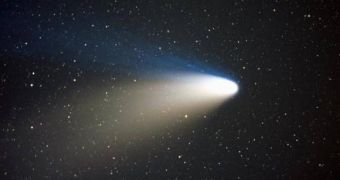Since the beginning of the human race, people have looked at incoming comets as telltale signs of either a god's will, or an omen of an imminent catastrophe. Rooted in popular culture, the celestial bodies have gained a negative reputation over the years, as being able to destroy all life on Earth. This line of thought was amplified by early hypotheses on the extinction of dinosaurs, which held that a comet had destroyed almost all life on Earth, an idea that has since come under intense criticism. Now, Experts at the tel Aviv University say that comets might have actually brought an important contribution to life on Earth, by bringing in chemicals the early organisms needed to develop.
“When comets slammed into the Earth through the atmosphere about four billion years ago, they delivered a payload of organic materials to the young Earth, adding materials that combined with Earth's own large reservoir of organics and led tot he emergence of life,” TAU Department of Geophysics and Planetary Sciences Professor Akiva Bar-Nun explained. The expert worked extensively in analyzing the chemical make-up of recovered comet fragments, and learned that these elements might have not been present on Earth at the time of the collisions.
The efforts of the team were focused on studying the argon, krypton and xenon noble elements, which do not degrade in the presence of oxygen, and whose proportions have reportedly remained constant over the entire life span of our planet. “Now, if we look at these elements in the atmosphere of the Earth and in meteorites, we see that neither is identical to the ratio in the sun's composition. Moreover, the ratios in the atmosphere are vastly different than the ratios in meteorites which make up the bulk of the Earth. So, we need another source of noble gases, which, when added to these meteorites or asteroid influx, could change the ratio. And this came from comets,” the expert added.
Bar-Nun argued that, in the early days of the solar system, stray water around the young Sun started crystallizing directly into ice, and then came together to form the core of comets. These celestial bodies usually have a temperature of -250 to -200 degrees Celsius, and also the ability to trap organic materials and cosmic gases inside. “The pattern of trapping of noble gases in the ice gives a certain ratio of argon to krypton to xenon, and this ratio – together with the ratio of gases that come from rocky bodies – gives us the ratio that we observe in the atmosphere of the Earth,” he shared, quoted by ScienceDaily.
The team also pointed out that, between 4.6 and 3.8 billion years ago, both the Earth and the Moon came under intense fire from a large amount of meteors and comets, which left their scars deep on our natural satellite. On the Earth, however, the continental drift and erosion caused by wind and water rendered most craters invisible. But the intense shower eventually brought sufficient amounts of noble gases into the atmosphere, which “were dissolved in the ocean and started the long process leading to the emergence of life on Earth,” Bar-Nun concluded.

 14 DAY TRIAL //
14 DAY TRIAL //